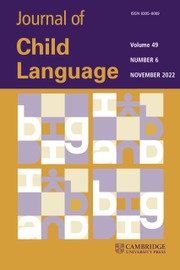Article contents
The acquisition of gone and the development of the object concept*
Published online by Cambridge University Press: 26 September 2008
Abstract
The relationship between the acquisition of gone and the development of the object concept is investigated. Children acquire gone at the same time that they solve serial invisible displacement tasks, in a transitional period in the development of the object concept. According to a ‘neo-piagetian’ account of the object concept, children move from using specific rules to predict the reappearance of objects, to using a general theory of object movements during this period. The children's uses of gone suggest that gone encodes the fact that the child does not perceive an existing object. This concept is an essential component of the new theory of objects developed in this period. Children seem to acquire gone when they are in the midst of developing the concept that gone encodes, which may explain why they acquire the word in this period. In this case, conceptual development does not precede semantic development; rather, conceptual and semantic development appear to proceed simultaneously.
Information
- Type
- Articles
- Information
- Copyright
- Copyright © Cambridge University Press 1984
Footnotes
Portions of this paper were presented at the International Congress for the Study of Child Language, Vancouver 1981, and the 1982 Waterloo Conference on Child Development. It is based on work undertaken for a University of Oxford doctoral dissertation, and on work under the Social Sciences and Humanities Council of Canada postdoctoral fellowship 457-82-0054. I am grateful to Andrew Meltzoff, Robbie Case and David Olson for helpful discussion and criticism, and to Guy Ewing for assistance in transcription and phonetic analysis. Address for correspondence: Department of Linguistics and Psychology, Scarborough Campus, University of Toronto, 1265 Military Trail, Scarborough, Ontario, Canada M1C 1A4.
References
REFERENCES
- 32
- Cited by

